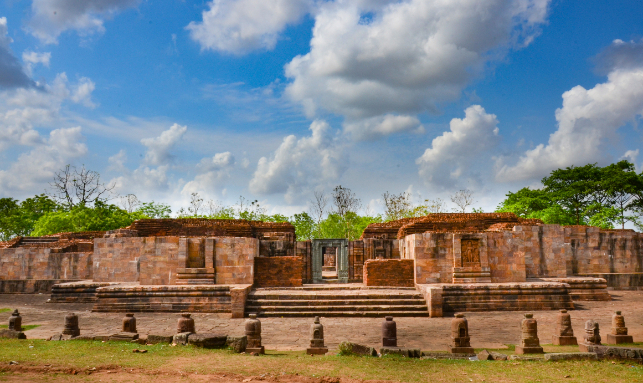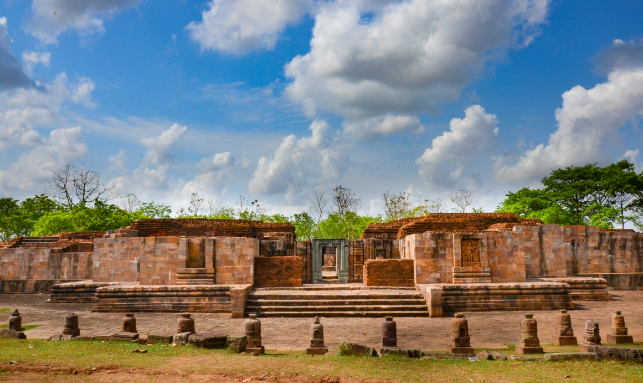Western Odisha, a region located in the state of Odisha in eastern India, holds a significant historical and cultural treasure – the Buddhist remains that provide a glimpse into the region’s rich Buddhist heritage. This area was once home to several thriving Buddhist monasteries that attracted scholars, philosophers, and disciples from far and wide. Today, these remains serve as a testament to the glorious past and the enduring influence of Buddhism in Western Odisha.
One of the most prominent sites that showcase Buddhist remains in Western Odisha is Ratnagiri. Located in the Jajpur district, Ratnagiri was one of the most important centers of Buddhism in ancient India. It flourished as a vibrant educational hub and religious pilgrimage site during the reign of the Gupta and post-Gupta dynasties. The remains at Ratnagiri consist of numerous stupas, viharas (monasteries), and beautiful sculptures that reflect the art and architecture of the time.
The main attraction at Ratnagiri is the grand and imposing monastery, which is believed to have housed hundreds of monks and scholars. The sanctum of the monastery contains an intricate and well-preserved statue of Buddha, surrounded by intricately carved walls depicting scenes from the life of the great sage. The spectacular stone carvings found here not only depict Buddhist deities but also showcase the artistic skills and craftsmanship of the artisans of that era.
Another significant Buddhist site in Western Odisha is Udayagiri, located in the Bargarh district. Udayagiri, meaning “Sunrise Hill,” is an ancient monastic complex that witnessed its heyday during the rule of the great Kalinga dynasty. The remains at Udayagiri comprise of stupas, chaityas (prayer halls), and a large number of rock-cut caves that served as dwelling places for the monks.

You can read our another post on Influence of Sri Chaitanya Bhakti in Odisha
One of the most impressive features of Udayagiri is the Rani Gumpha or Queen’s Cave, which houses beautiful ancient sculptures and inscriptions. The walls of this cave are adorned with unique and rare depictions of Buddha and various motifs associated with Buddhism. The inscription found here provides valuable insights into the development of Buddhism in the region and the patronage it received from the rulers of that time.
Apart from Ratnagiri and Udayagiri, Western Odisha is also home to several other lesser-known Buddhist sites such as Lalitgiri, Langudi, and Dhauli. These sites, though smaller in scale, possess their own distinct charm and archaeological significance. Exploring these sites allows one to delve deeper into the profound teachings and cultural nuances of Buddhism in ancient India.
The Buddhist remains in Western Odisha not only offer a unique travel experience for history and culture enthusiasts but also provide an opportunity to reconnect with the spiritual heritage of the region. They offer a glimpse into the lives of ancient civilizations and the profound impact Buddhism had on the people of this land. The serene and tranquil ambiance of these sites also lends itself perfectly to introspection and meditation, allowing visitors to experience a sense of peace and inner calm.
Preserving and promoting these Buddhist remains is crucial for their conservation and for enhancing our understanding of the cultural diversity of Odisha. Efforts should be made to ensure their protection and maintenance, while also raising awareness about their historical and religious significance. These sites have the potential to attract both domestic and international tourists, promoting tourism in the region and contributing to the economic development of the local communities.

Write A FAQ For Buddhist Remains in Western Odisha
What are Buddhist remains in Western Odisha?
Buddhist remains in Western Odisha refer to the archaeological sites and relics associated with Buddhism that have been discovered in the region. These remains include ancient monasteries, stupas, statues, and inscriptions that provide insights into the spread and practice of Buddhism in the area.
Where are these Buddhist remains located in Western Odisha?
The Buddhist remains in Western Odisha are scattered across various districts in the region. Some prominent sites include the Udayagiri and Langudi hills in Jajpur district, Lalitgiri and Ratnagiri in Cuttack district, and Chudangagarh in Sambalpur district. These sites have been excavated by archaeological teams and are open to visitors.
What is the significance of these Buddhist remains?
The Buddhist remains in Western Odisha hold immense historical and cultural significance. They provide evidence of the existence and influence of Buddhism in this region during ancient times. The remains suggest that Buddhism flourished here and attracted followers, leading to the establishment of monastic complexes and other infrastructure.
Are these Buddhist remains well-preserved and accessible to the public?
Most of the Buddhist remains in Western Odisha have been well-preserved through excavations and restoration work. These sites have also been developed into tourist attractions, with proper pathways, signage, and information boards for visitors. However, some sites may require visitors to take a short hike or climb stairs.
Can visitors learn more about Buddhism at these sites?
Yes, visitors can learn more about Buddhism and its practices by exploring the Buddhist remains in Western Odisha. Several interpretive centers and museums have been established near these sites to provide detailed information about the historical and cultural significance of Buddhism in the region. Visitors can also engage with local guides who explain the significance of various relics and answer questions related to Buddhism.
Conclusion
In conclusion, the Buddhist remains in Western Odisha offer a fascinating glimpse into the rich cultural and religious history of the region. Exploring these ancient sites not only provides a deeper understanding of Buddhism but also allows one to experience the tranquility and spiritual aura that these places exude. It is essential to preserve and promote these sites, for they are a precious legacy that connects us to our ancient past and serves as a source of inspiration for future generations.
